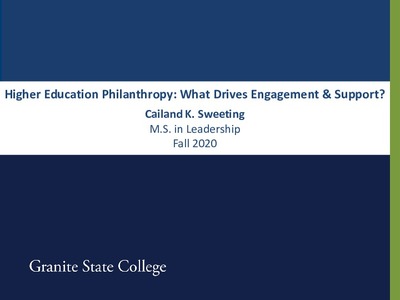| dc.description | This study examines the role power, morality, gift officer efficacy, and overall engagement to a higher education institution plays in driving philanthropic motivations. It is clear that gift officers and development professionals must maintain positive one-on-one relationships with their constituents, where those constituents view them as trusted advisors, power is properly utilized and harnessed to promote in-group engagement, and transparency is maintained through all forms of communication (Argenti, 2011; Liu et al., 2019; Maftei, 2020). The method and quality of the one-on-one relationship is crucial: morality, empathy, affinity, and mechanism of communication all must be taken into consideration and reassessed on a continual basis. This study also addresses the role of transformational and transactional leadership in a fundraising environment. Essentially, this study is a comprehensive look at both the method and process for successful fundraising leadership—and provides a framework for best practices in a public higher education institution. | |

